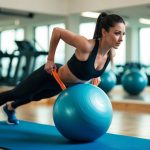
Functional fitness has emerged as a transformative approach to enhancing physical performance, focusing on improving strength and stamina for everyday tasks. Unlike traditional workouts that target isolated muscles, functional fitness emphasizes movements that mimic real-life activities, promoting better coordination and balance. The key to unlocking the secrets of functional fitness lies in its ability to enhance everyday functionality, making daily activities more manageable and reducing injury risk.
The benefits of functional fitness extend beyond the gym, as it prepares the body for the demands of real-life activities. By integrating exercises that improve core stability, flexibility, and endurance, individuals can experience increased efficiency in their daily routines. This approach not only supports physical health but also contributes to mental well-being, as a strong, adaptable body fosters confidence and resilience.
Embracing functional fitness can lead to a more active and fulfilling lifestyle. As people incorporate these practices into their routines, they may notice improvements in posture, agility, and overall energy levels. For those seeking a comprehensive fitness strategy that aligns with natural body movements and supports a balanced life, functional fitness offers a promising path to enhanced performance.
Foundations of Functional Fitness

Functional fitness focuses on exercises that mimic real-life activities and enhance performance in daily tasks. Key principles involve improving movement patterns and functional movement structures to build strength and stability.
Defining Functional Fitness
Functional fitness is a training method designed to better prepare individuals for activities encountered in everyday life. It revolves around exercises that replicate movements common in daily tasks, such as lifting, squatting, and reaching. The primary goal is to improve strength, balance, coordination, and flexibility.
Emphasis is placed on multi-joint movements rather than isolated exercises. This approach enhances overall functional movement efficiency by engaging multiple muscle groups. Functional fitness goes beyond traditional weightlifting by incorporating dynamic, full-body movements that align with natural human biomechanics.
The adaptability of functional exercises makes them suitable for people of various fitness levels and ages. Trainers focus on personalized routines that cater to the unique goals and needs of each individual. This methodology supports injury prevention and overall health by promoting the natural strength required for active living.
Core Principles of Functional Training
Functional training is grounded on several essential principles that guide its application. One fundamental aspect is the focus on movement patterns reflective of real-world actions, such as bending, twisting, and pushing. These exercises train the body to perform integrated movements efficiently.
The integration of stability and mobility ensures that individuals develop not just strength but versatile and adaptable movement skills. Exercises are often performed in various planes of motion, encouraging better multi-directional agility.
Another principle is the adaptability of training programs, which are tailored to suit individual needs. Trainers often incorporate equipment like kettlebells, resistance bands, and stability balls to add variety and challenge. These tools help create balanced workouts that advance core strength and functional capabilities.
Physical Components of Functional Fitness

Functional fitness involves several foundational physical components that work together to improve overall performance. These components include building muscular strength, increasing endurance, enhancing balance and stability, and fostering flexibility and mobility. Each aspect plays a critical role in optimally preparing the body for various physical challenges and activities.
Building Strength and Endurance
Strength training is a core element of functional fitness. It emphasizes exercises that mimic everyday movements, focusing on developing key muscle groups. Functional exercises like squats and deadlifts help improve muscular endurance, allowing the body to perform tasks for longer periods without fatigue.
Endurance is equally important. It involves sustained physical activity over time, which strengthens the cardiovascular system and boosts energy levels. Practices like circuit training can effectively combine strength and endurance components, leading to better overall fitness.



